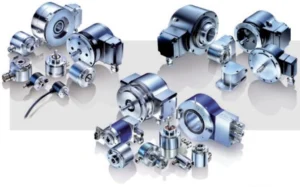In the world of automation, precision is everything. Whether you’re operating a high-speed packaging line or managing a heavy-duty crane, having the right encoder in place can make all the difference. Optical and magnetic encoders might look similar on the outside, but what happens inside tells a different story. So, how do you know which one’s right for your setup? Let’s break it down.
Why Encoders matter in industrial applications
Encoders are the unsung heroes behind smooth, controlled movement in industrial machines. They convert motion into data, allowing systems to monitor speed, position, and direction with impressive accuracy. Not sure how they work? Check out our quick explainer on what are encoders. Get the wrong encoder, though, and you’re looking at frustrating downtime, errors in positioning or worse, equipment failures.
How optical Encoders work
Think of optical encoders like a precision light show. They use a light source—usually an LED—and a transparent code disk with fine patterns. As the disk spins, light passes through these patterns and hits sensors that translate those interruptions into readable signals.
This setup gives you incredible resolution and accuracy, which is why optical encoders are common in robotics, CNC machines, and medical equipment. But there’s a catch: they don’t like dust, vibrations, or rough handling. A little contamination or misalignment, and performance can drop quickly.

How magnetic Encoders work
Magnetic encoders take a more rugged approach. Instead of light, they rely on magnetic fields. A magnetized disc rotates past sensors—often Hall effect or MR sensors—which detect changes in the field and turn that into data.
They’re not as delicate as optical systems and can easily handle dirt, shock, and even water. That makes them ideal for outdoor use or in harsh environments like marine, mining, or heavy industry. Some brands, such as Baumer encoders, offer magnetic variants with surprisingly high precision and compact design.
Optical vs Magnetic – side-by-side comparison
| Feature | Optical Encoder | Magnetic Encoder |
|---|---|---|
| Precision | Extremely high, perfect for fine-tuning | Good and constantly improving |
| Environment | Best in clean, stable settings | Built for dirty, rough conditions |
| Durability | Sensitive to dust and shock | Tough and resistant to elements |
| Cost | Higher price point | More budget-friendly |
| Size | Can be larger | Often compact |
| Use Cases | Robotics, CNC, labs | Cranes, conveyors, industrial equipment |
When to choose which Encoder
Not every application needs laser-like precision—and not every setup can tolerate fragile components. That’s why knowing your priorities helps.
If your machine operates in a stable, controlled environment and demands pinpoint accuracy, go optical. Think lab automation, high-end robotics, or detailed machining.
But if your setup lives in the real world—with dust, temperature swings, vibrations, or weather—magnetic encoders are your reliable workhorse. They’re built to survive, and they keep performing even when conditions aren’t perfect.
Go optical when:
- You need extreme precision
- You operate in a dust-free, vibration-free environment
- Your machinery cannot tolerate drift or recalibration
Go magnetic when:
- You’re in harsh industrial environments
- You need compact size and long-term durability
- Budget and maintenance intervals matter
Tips from the field – Euro Hübner’s take
At Euro Hübner, we’ve seen both ends of the spectrum. Take offshore cranes, for example. They’re exposed to salt air, constant movement, and heavy loads. In that environment, a magnetic encoder outperforms because of its resilience. On the other hand, for high-speed paper production where even the slightest deviation matters, an optical encoder wins every time.
We don’t just sell encoders—we engineer solutions. By looking at your operating environment, required precision, maintenance capabilities, and long-term goals, we help you choose the encoder that works for you, not against you.

What’s next for encoder technology?
As machines become smarter and more connected, encoders are evolving too. Hybrid models are emerging, mixing technologies like capacitive or inductive sensing to get the best of both worlds. Whether it’s even higher resolution or better durability in smaller form factors, the next generation of encoders is all about combining intelligence with resilience.
Optical encoders and magnetic encoders
Choosing between optical and magnetic encoders isn’t just a technical decision, it’s a strategic one. It’s about aligning your machinery’s needs with the right technology to boost performance, reduce downtime, and extend the life of your systems. Need help deciding? Our engineers at Euro Hübner are happy to guide you with honest, practical advice.